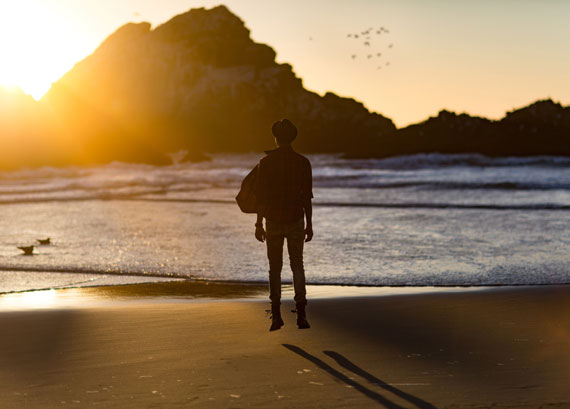Levitation is one of the most intriguing subjects in trick photography; it has inspired millions of people since its invention in the mid-19th century. The ability to harness the creative aspects of the photographer and combine it with real-life images has resulted in a combined revolution of art and science.
photo by Photo Vanova
One of the simplest, yet most overwhelming and inspiring feelings is found in the types of photographs where the subject seems to levitate above the ground. Levitation photography is still one of the most eye-catching and spectacular types of photographic subjects. However, despite the seemingly complex nature of these photographs, many of them are simple to achieve, either all in-camera, or with the use of technology such as Photoshop or an application on your phone.
For most amateur or aspiring photographers, the ability to improve picture-taking skills is actually easier than we might think. This article shows you how to incorporate this type of special effect into your repertoire. The following techniques will help you accomplish levitation photography:
Jumping Technique
The most spectacular effects are the simplest of all to photograph. The subject simply jumps in place, above the ground, and then the photographer snaps the picture. There are no post-production or editing effects required, since everything takes place inside the camera. However, it does take more than just simple jumping to achieve the effect.
Stationary objects should also be included. In other words, the levitation effect is more pronounced when we see objects that are normally stationary in the frame of the picture, such as a house, vehicle, furniture, or any type of stationary object in a levitated position.

Photo captured by Saksham Gangwar; ISO 100, f/1.8, 1/8000s, 85mm.
The human subject must not look like he or she is jumping. You can achieve this stationary position with a calm expression on the face, slight bending of the knees so that the feet appear to be floating effortlessly off the ground, and some kind of rigidity in the clothing that does not give away the subject’s motion.
If your subject has long hair, it’s important to press the shutter button during the middle of a jump and not in the final phase while the subject is descending with their hair appearing to be hanging from the sky. You can also use hair styling product to minimize hair movement to make the shoot easier.
The shutter speed on your camera must be set fast enough so that there is no motion blur. You can hire a skilled model, particularly a dancer or athlete who is accustomed to jumping, to create a more realistic effect.
Double Frame Technique
The next type of levitation trick is using objects, for example stools and ladders, to support the subject. After this, you mask out the subject in post-production editing with the use of photo editing software (e.g. Adobe Photoshop). This is perhaps the most common type of levitation photography.
photo by Lucy Maude Ellis
This type of levitation photography can achieve some spectacular effects if done correctly. You should ensure that objects used to support the subject are easy to remove in post-production editing. To perform the post-production editing, you will require double frames (i.e. shoot two images for post-processing).
Double Frame Levitation Photography Tips
- Use a sturdy tripod to hold your camera, and place the tripod at a fixed position for the entire shoot.
- Use manual mode on your camera to achieve your desired lighting exposure, and maintain the same setting for your entire shoot.
- Use manual focus-mode on the camera lens to achieve the desired focus point on your subject, and maintain the same focus point for your entire shoot.
- Consider using a remote shutter release or set your camera on self-timer mode if you are modeling for your own shoot.
- While shooting multiple frames, the first image should consist of only the background without the subject and supporting object. The second image should consist of the exact same background but with your subject and the required supporting object.
- After capturing the images, you will need to use Photoshop or other editing software to align the two images. You can then easily remove the supporting object by using the masking technique.
photo by Louish Pixel
In essence, there needs to be a significant color difference between the supporting objects and the subject itself. This makes it easier to isolate and remove the supporting object while editing.
Tips for More Realistic Levitation Photography
- Try to include or create shadows of your levitating subject. You should shoot the picture under soft lighting to achieve soft shadows, as it will make your work easier during post-production editing. When necessary, you can clone out the shadow of the supporting object and add in artificial shadows using the burn tool in Adobe Photoshop.
- The more complex the background, the more believable the levitation. Using a simple, solid color background makes it very easy to achieve levitation effects. However, the more complex and natural the background, the more believable the image. Removing and replacing the support structure is more difficult to achieve.
photo by Louish Pixel
If you apply the above tips and tricks, you will definitely add wings to your existing portfolio. Expert levitation photography draws an impressed audience at a quicker rate.
About the Author:
Swee Shiong Chong writes for SG East Photography, a photography blog on techniques and equipment that is used in creating all types of photography from around the world.
Go to full article: Levitation Photography: Techniques for Defying Gravity
What are your thoughts on this article? Join the discussion on Facebook
PictureCorrect subscribers can also learn more today with our #1 bestseller: The Photography Tutorial eBook
The post Levitation Photography: Techniques for Defying Gravity appeared first on PictureCorrect.
from PictureCorrect https://ift.tt/2XLUqWG
via IFTTT






0 kommenttia:
Lähetä kommentti